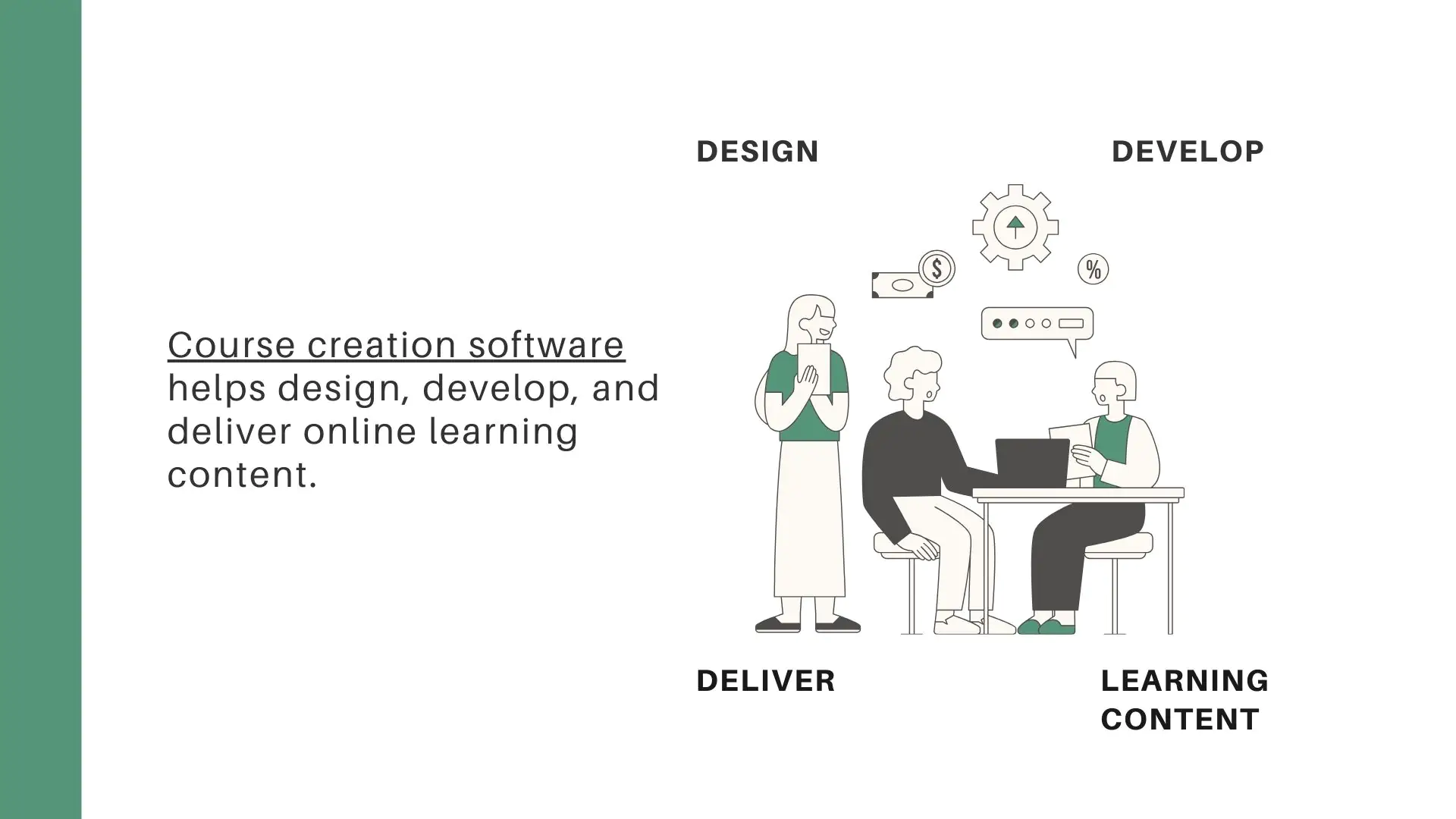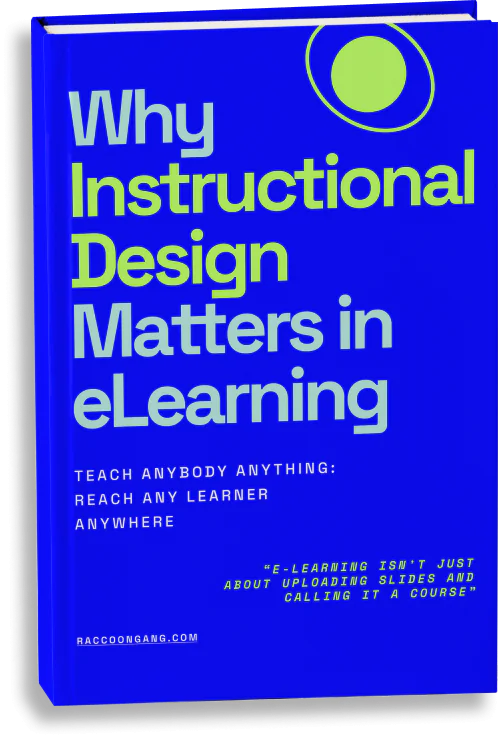Choosing the right online course software sets the foundation for memorable learning experiences. Whether you’re an educator building a new curriculum, a corporate trainer rolling out compliance modules, or an entrepreneur packaging your expertise, from this article, you’ll learn:
- How the platform you pick shapes everything from how smoothly you assemble video lessons to how reliably you track learner progress
- How to avoid costly missteps that can leave you wrestling with clunky interfaces, missing engagement opportunities, and frustrating your students
- Which top-rated online course software solutions deliver the right mix of features?
Course creation software (often called eLearning software) is a platform that enables educators to design, develop, and deliver online lessons, lectures, and seminars. These tools support a mix of multimedia content like videos, images, graphics, audio clips, and text, so you can develop online courses with rich, interactive experiences for your learners.
“Good eLearning development software shouldn’t lock you into rigid templates. We build custom solutions that let you mix videos, quizzes, and community features exactly the way you want so your course feels as unique as your content.” — Raccoon Gang’s EdTech Engineer
Beyond content assembly, this course creation software typically includes features for building quizzes, assignments, and self-assessment tasks. After learners engage with the material, they complete tests or submit reflections directly within the platform, providing instant feedback and data on their progress.
Recent data underline the power of interactive content: 70% of K–12 teachers report higher focus when students participate rather than listen; game-based quizzes boost test scores in 70% of studies; swapping live lectures for short videos raises average grades by 28%; micro-lectures drive a 24.7% engagement jump and 9% exam bump; embedding quizzes into lessons can lift outcomes by up to 50%; and 83% of corporate learners prefer video, with 75% watching at least one how-to video weekly.
Prioritize tools that deliver clear analytics, enabling you to identify which modules resonate with learners and where they struggle. Ease of collaboration, mobile-friendly delivery, and reliable support should all weigh in on your decision. By setting these criteria up front, you’ll avoid the headache of feature overload and hone in on the platforms that truly empower your goals:
- Define your primary goal (knowledge transfer, certification, revenue growth) to guide feature priorities
- List must-have capabilities and interactive learning tools: video hosting, interactive quizzes, discussion forums, e-commerce, analytics dashboard
- Sign up for free trials or demos and build a small pilot module to test the authoring workflow
- Evaluate how each tool handles eLearning software standards (SCORM/xAPI) and LMS integration
- Check mobile playback and offline access if your learners need on-the-go study options
- Compare pricing tiers against your expected audience size and revenue model
- Look for active user communities and vendor support channels for ongoing help
- Review real-world case studies, ideally from providers who’ve worked on custom Open edX services, to gauge scalability.
Key Features to Look for in Online Course Software
Once learners work through your modules, they can tackle quizzes or jot down reflections right in the platform, so you get instant feedback on how they’re progressing. When you’re choosing course creation software, look for a natural drag-and-drop editor, reliable multimedia support for video and audio, and seamless connections to your payment system or LMS for course monetization.
Intuitive Authoring and Interactive Learning Tools
Your course creation software should feel like an extension of your own creativity. Seek out a drag-and-drop editor that makes arranging video, text, and audio as simple as moving cards on a board. Built-in quiz builders, discussion forums, and live feedback widgets transform passive content into interactive learning tools that keep students engaged without messy plugins. For a national education project, we supercharged engagement by integrating game mechanics that turned course completion into a mission with AI-adjusted challenges and Telegram mentor bots driving an 80% sustained participation rate.
Payment Solutions and Monetization
When figuring out how to create an online course platform, turning your expertise into revenue starts with choosing a learning management system that handles transactions smoothly. Look for support of major payment gateways, multiple pricing options (one-time purchases, subscriptions, bundles), and transparent fees. A straightforward checkout path in your LMS reduces friction and helps convert curious browsers into paying learners.
Integrations and Flexibility
Your ideal platform should fit neatly into your existing tech stack. Strong APIs and ready-made connectors for email marketing, CRM, or analytics dashboards let you automate enrollments, trigger personalized messages, and keep learner data in sync—no custom code required. True flexibility means you can add features or adjust workflows as you grow, rather than being boxed into rigid templates.
Ease of Use, Support, and Mobile Learning
A steep learning curve wastes time you could spend teaching. Choose one of the best online course platforms with clear documentation, friendly support channels, and an intuitive interface. And because many learners study on the move, robust mobile learning features (e.g., responsive design, native apps, and offline access) make sure your courses work flawlessly on any device. Our Open edX mobile app development for Axim Collaborative resulted in a 68% increase in learner engagement, with 42% of users accessing courses offline, proving that mobile optimization directly impacts accessibility and completion rates.
Analytics and Continuous Improvement
Insights are everything. Seek out a comparison of the LMS solutions that offer deep analytics—module completion rates, time on task, quiz scores, and heatmaps highlighting popular content. With this data, you can spot learners who need help, refine confusing lessons, and double down on what resonates. Turning each cohort into a testing ground lets you sharpen both material and delivery.
Security, Compliance, and Scalability
As your audience grows, you need a platform that keeps pace. Look for the best online course platforms that meet data-protection standards, including SSL encryption, GDPR or FERPA compliance, and support SCORM compliance for portability. Enterprise-grade systems provide role-based permissions, single sign-on, and uptime guarantees, ensuring your training never misses a beat. Building on a secure, scalable foundation frees you to focus on innovation, not server upkeep.
Top 5 Online Course Builder Software
Here are five standout course creation software options, each with its own strengths and pricing nuances. We’ve broken down their core features, pros and cons, ideal users, and pricing policies. Here’s a short version if you want a quick reference:
| Platform | Use Case | Key Strengths |
| Open edX | Large-scale courses and custom LMS builds | Scalable, open-source, modular |
| Kajabi | Professional marketers and course sales | All-in-one, marketing funnels |
| Thinkific | Automated workflows and course management | Drip scheduling, zero transaction fees |
| Teachable | Beginners launching their first course | Simple, fast setup |
| Adobe Captivate | Rich, interactive, and multimedia content | Advanced simulations, SCORM output |
Each of these eLearning development software options offers a unique balance of features, pricing, and ideal use cases. Align your goals: whether it’s full customization with an open-source LMS, integrated marketing with Kajabi, beginner-friendly tools with Thinkific or Teachable, or immersive interactivity with Adobe Captivate, and choose the platform that best serves your project and audience.
Open edX
Open edX is a leading open-source learning management system created by Harvard and MIT. It powers massive open online courses and custom academic programs worldwide.
“It’s a free, community-powered platform that gives schools insane flexibility whether they’re spinning up quick workshops or full-blown degree programs. Best part? You keep your data and branding, no strings attached.” — Raccoon Gang’s EdTech Architect
Best for universities, nonprofits, and enterprises with technical expertise, Open edX scales effortlessly and can be adapted to complex custom LMS development requirements without vendor lock-in.
Core Features:
- Modular course structure with XBlock extensions
- Built-in discussion forums, video hosting, quizzes, and certificates
- Advanced analytics dashboards for learner progress and engagement
- Multi-tenant architecture for managing multiple schools or departments.
Pros:
- No licensing fees or usage limits
- Highly customizable UI and workflows
- Robust community support and frequent updates
- Proven reliability at top universities and organizations
Cons:
- Requires IT resources to deploy and maintain
- Steep learning curve for administrators and authors
- Lacks built-in marketing and e-commerce tools
Pricing:
- Software: Free to download and modify under an open-source license
- Hosting: Costs vary. Self-host on your own servers or choose a managed Open edX hosting provider (typically $500–$5,000+ per month, depending on scale)
Kajabi
Kajabi is an all-in-one eLearning software and business platform. It combines website hosting, course creation, email marketing, course monetization, and payment processing under one roof. Its marketing automation features, like drip campaigns, funnels, and membership sites, help creators monetize quickly. If you’re an entrepreneur or coach who wants a turnkey solution without stitching together multiple tools, Kajabi delivers. Just be ready to invest, as its premium pricing reflects its broad feature set.
Core Features:
- Drag-and-drop course and site builder
- Automated email sequences and sales funnels
- Integrated checkout with coupons, subscriptions, and affiliate tracking
- Mobile-ready academy and member community pages
Pros:
- Unified platform for content and marketing
- Professional templates and easy branding
- Responsive support and extensive training materials
- Regular feature enhancements
Cons:
- Higher cost compared to niche tools
- Limits on products and contacts at lower tiers
- Less flexibility for deep customization
Pricing:
- Basic: $149/month (up to 3 products, 1,000 active members)
- Growth: $199/month (up to 15 products, 10,000 active members)
- Pro: $399/month (up to 100 products, 20,000 active members)
Annual billing discounts apply; all plans include zero transaction fees.
Thinkific
Thinkific is a popular online course software choice among solo instructors and small businesses. It strikes a balance between simplicity and power, offering course creation software that anyone can master in minutes. With no transaction fees on paid plans, you keep every penny of your revenue. Thinkific scales well from a single course to a full online school, and it integrates with marketing tools and CRMs. Ideal for creators who want a polished site without dev work.
Core Features:
- Customizable themes and site builder
- Automated drip schedules and certificates
- Affiliate program and coupon management
- Zapier and API integrations for marketing automation
Pros:
- Zero transaction fees on paid plans
- Intuitive interface and quick setup
- Strong customer support and community
- Generous plan limits for courses and students
Cons:
- Free plan discontinued, requiring a paid subscription to launch
- Advanced features (multiple admins, removal of branding) require higher plans
- Basic community tools; deeper interactivity needs add-ons
Pricing:
- Starter: $49/month (1 site, limited features)
- Growth: $79/month (unlimited courses, memberships)
- Pro: $159/month (advanced features, up to 5 admin accounts)
All paid plans include unlimited students and no transaction fees.
Teachable
Teachable makes it easy for beginners to turn expertise into revenue. You upload your content, set prices, and start selling without worrying about hosting or updates. The platform handles payment processing, student management, and course delivery with minimal fuss. Teachable’s simplicity is its greatest asset, but it can feel limiting if you need advanced features or deep design tweaks. Best for coaches, consultants, and solo creators launching a first course.
Core Features:
- Simple course editor with video, text, and quiz modules
- Integrated payment processing and sales pages
- Built-in affiliate management and coupons
- Basic student analytics and progress tracking
Pros:
- Very low barrier to entry and minimal setup time
- Free plan available (with transaction fees) and affordable paid tiers
- Reliable hosting and automatic updates
- Helpful onboarding guides and tutorials
Cons:
- 5% transaction fee on the Basic plan
- Limited design customization and SCORM support
- A few advanced engagement features
Pricing:
- Free: 5% transaction fee, basic features
- Basic: $29/month + 5% fee
- Pro: $99/month, no transaction fee
- Business: $249/month, advanced features, and bulk student import
Adobe Captivate
Adobe Captivate stands apart as a professional eLearning authoring tool in the eLearning development software landscape. It’s designed for creating richly interactive content—software simulations, branching scenarios, VR experiences and more. Captivate projects can be exported as SCORM-compliant packages to any LMS, making it a versatile choice for corporate or academic use. Expect a steep learning curve, but the creative freedom and multimedia power are unrivaled.
Core Features:
- Screen recording and software simulation tools
- Responsive design with fluid boxes and breakpoints
- Advanced quizzing, drag-and-drop and VR integration
- HTML5 publishing for any SCORM/xAPI-capable LMS
Pros:
- Unmatched interactivity and multimedia support
- Tight integration with Adobe Creative Cloud
- Extensive community and learning resources
- Ideal for complex, scenario-based training
Cons:
- Steep learning curve for new users
- Desktop software only (Windows/Mac)
- Requires significant time to master
Pricing:
- Subscription: $33.99/month (annual commitment)
- Perpetual License: $1,299 one-time purchase
Includes two-user install rights; volume discounts available for enterprises.
The Ultimate Comparison of the Best Online Course Platforms
| Platform | License / Pricing | Target Users | Customization & Flexibility | Ease of Use & Support | Key Strength |
| Open edX | Free open-source; hosting from $500+/mo | Universities, large enterprises, NGOs | Fully customizable LMS solutions via XBlocks and APIs | Requires technical expertise; strong community support | Scalable, branded open-source LMS |
| Kajabi | $149–$399/mo (no transaction fees) | Solo entrepreneurs, coaches, SMEs | Page builder plus marketing automations; limited code access | Intuitive UI; excellent tutorials | Integrated marketing automation and sales funnels |
| Thinkific | $49–$159/mo (no transaction fees) | Independent creators, small to mid-sized schools | Custom themes and API integrations; zero fees on paid plans | User-friendly; strong knowledge base | Balance of customization and no transaction fees |
| Teachable | Free–$249/mo; 5% fee on Basic plan | Beginners, coaches, consultants | Basic templates, limited branding, no SCORM support | Very easy setup; reliable hosting | Simple publishing and course sales |
| Adobe Captivate | $33.99/mo or $1,299 perpetual license | Instructional designers, corporate L&D | Advanced interactivity; responsive design; VR/360 support | Steep learning curve; robust community | Professional eLearning authoring tool |
Wrap-Up & Next Steps
We’ve explored everything from powerful open-source LMS like Open edX to sleek drag-and-drop online course software and advanced eLearning software that brings interactivity to life.
Each of the best online course platforms has its sweet spot—some give you complete control, others simplify marketing, or turbocharge content creation. Here’s a quick plan: grab a notebook, list your priorities, including audience size, tech comfort, mobile learning needs, and budget, then spin up a test course on two or three platforms. You’ll quickly see which course creation software feels right.
When you’re ready for something truly unique, our LMS solutions team at Raccoon Gang can build custom eLearning development software just for you. Reach out for a free consultation, and let’s design the perfect platform to match your vision and your learners’ needs.




